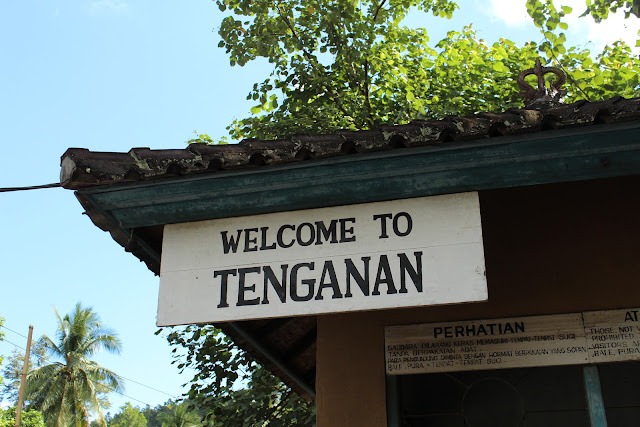My first stop on this textile research adventure was the village of Tenganan in Bali, Indonesia.
Tenganan is one of only 3 places in
the world to produce/weave Geringsing. The other two places are Gujarat in
India and Okinawa in Japan. Geringsing is the rarest technique of ikat weaving
in the world today. Even though there are two other locations practicing
Gerinsing weaving, the weaver I had the fortune of talking to said that they are not as advanced as
the textiles produced in Tenganan; the process was created in Tenganan and the
Japanese and Indian weavers have not quite figured out the skill of matching up
the warp and weft patterns.
Before I explain
more about the textile traditions and techniques, I will describe some of the
cultural importance of Tenganan. The village is set up in a system of “levels”.
Once you enter the gates of Tenganan, the further you venture forth, the higher
you climb. The organization of who lives where depends on age. At the bottom of
the village are the youngest families and at the top are the eldest in the
village.
The population of the village stays abnormally stable, as marriage is
kept within the city walls and amongst the people of the village. This village
has an infamous tradition, according to our outsider Balinese tour guide. However, he stated that no one knows if they still practice it today as the village people are
very secretive about their rituals. Couples in the village of Tenganan were not
wed through love or even arrangement, but by chance. The story goes that once
every five years, all the males and females aged 12-16 would go out into
a field that contained a very high wall. The males would be on one side, each
holding a token of their choice ie. a flower, a toy, a shoe. They would then
blindly throw it over the wall to the females and whoever caught their
corresponding trinket would become their wife. This tradition had no
exceptions- whether it was your own sister, cousin or any other relation, you
still had to marry them.
As for their
textiles, to properly explain the term ikat, I will describe the scene I
encountered in Tenganan. I went into the first house I saw on the first level. The
woman’s studio doubled as her shop, and amongst the hanging textiles was a
raised platform on which she sat, tied up in her back-tension loom (below).
The
back-tension loom is a device that wraps behind the weaver’s back and around
his/her feet to hold the warp threads in tension. She is hunched over the
threads, painstakingly matching up the indigo dyed weft thread wrapped around a
wooden shuttle with the tense warp threads.
Ikat
is a distinctive technique of creating textiles because it dyes the yarn before
the textile is woven. This process is done by wrapping the yarn with small
strips of palm leaf or similar materials to prevent dye from penetrating the
fiber. As additional colors are added to the yarn design, depending on the
design, the palm leaves will be either partially removed or added.
Upon the
dying of the last color, all the bindings are removed and the yarn is ready for
the loom.
So,
again, Geringsing technique is so rare because this process will be done to
both the warp yarn (parallel threads running longitudinally on the loom) and
the weft yarn (the yarns that traverses by crossing and interlacing with the
warp yarn). Instead of having plain warp threads and just making sure the weft
threads line-up (single ikat) the weaver has to make sure that the warp and
weft designs align as well.
These textiles
are not frivolous decorative material to the Tenganan people. They are
incredibly important and are only used for ceremonial purposes. Firstly,
because the ikat takes months and months to produce (and in many cases, years),
when the order is put in for a specific ceremony, they have to plan far in
advance so that the weaver has time to choose an auspicious day to begin the
weaving process, while still being able to finish the cloth before the ceremony
date. However, speaking to one of the artisans, she noted that many people of
today’s generation don’t have the skill or patience for such a long process,
especially with the ubiquitous presence of machines that can make the fabric in
a fraction of the time and cost it would take to hand-weave it.
The
most important textiles are only used once a year for temple ceremonies and are
kept in a safe location in the village the rest of the year.
The fabric is
believed to have it’s own energy and spirits due to the labor-intensive
production process. The priests wear the fabric to protect themselves against
evil spirits. Such is the downside of machine-made fabric, they lack the energy
and spirits generated by the hand-woven process.
There
are 24 different motifs found in Tenganan ikats. The most traditional pattern
produced in Tenganan is the motif of the 900 hector village- a black diamond-shape
set against the red dye from roots of trees or animal blood.
The dyes are made
from blood of cows or pigs. Only “true” ikat fabrics are made with blood dye,
and the colors from these dyes increase in brightness over time. The most
revered piece in her shop was a large skirt cloth (below) which had the traditional village
motif and took seven years for her to weave.









